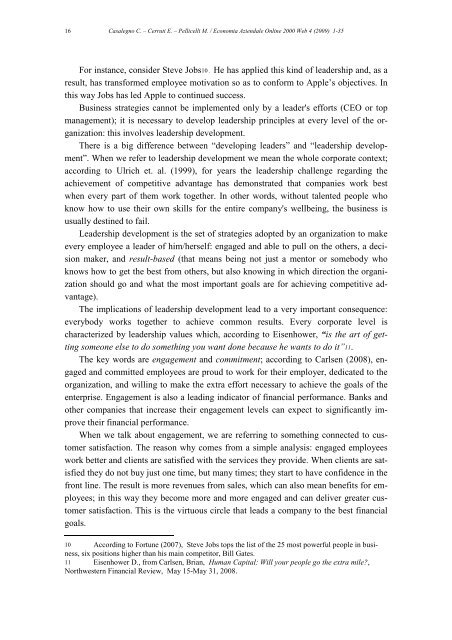Download this PDF file - Riviste
Download this PDF file - Riviste
Download this PDF file - Riviste
You also want an ePaper? Increase the reach of your titles
YUMPU automatically turns print PDFs into web optimized ePapers that Google loves.
16Casalegno C. – Cerruti E. – Pellicelli M. / Economia Aziendale Online 2000 Web 4 (2009) 1-35For instance, consider Steve Jobs10 . He has applied <strong>this</strong> kind of leadership and, as aresult, has transformed employee motivation so as to conform to Apple’s objectives. In<strong>this</strong> way Jobs has led Apple to continued success.Business strategies cannot be implemented only by a leader's efforts (CEO or topmanagement); it is necessary to develop leadership principles at every level of the organization:<strong>this</strong> involves leadership development.There is a big difference between “developing leaders” and “leadership development”.When we refer to leadership development we mean the whole corporate context;according to Ulrich et. al. (1999), for years the leadership challenge regarding theachievement of competitive advantage has demonstrated that companies work bestwhen every part of them work together. In other words, without talented people whoknow how to use their own skills for the entire company's wellbeing, the business isusually destined to fail.Leadership development is the set of strategies adopted by an organization to makeevery employee a leader of him/herself: engaged and able to pull on the others, a decisionmaker, and result-based (that means being not just a mentor or somebody whoknows how to get the best from others, but also knowing in which direction the organizationshould go and what the most important goals are for achieving competitive advantage).The implications of leadership development lead to a very important consequence:everybody works together to achieve common results. Every corporate level ischaracterized by leadership values which, according to Eisenhower, “is the art of gettingsomeone else to do something you want done because he wants to do it”11.The key words are engagement and commitment; according to Carlsen (2008), engagedand committed employees are proud to work for their employer, dedicated to theorganization, and willing to make the extra effort necessary to achieve the goals of theenterprise. Engagement is also a leading indicator of financial performance. Banks andother companies that increase their engagement levels can expect to significantly improvetheir financial performance.When we talk about engagement, we are referring to something connected to customersatisfaction. The reason why comes from a simple analysis: engaged employeeswork better and clients are satisfied with the services they provide. When clients are satisfiedthey do not buy just one time, but many times; they start to have confidence in thefront line. The result is more revenues from sales, which can also mean benefits for employees;in <strong>this</strong> way they become more and more engaged and can deliver greater customersatisfaction. This is the virtuous circle that leads a company to the best financialgoals.10 According to Fortune (2007), Steve Jobs tops the list of the 25 most powerful people in business,six positions higher than his main competitor, Bill Gates.11 Eisenhower D., from Carlsen, Brian, Human Capital: Will your people go the extra mile?,Northwestern Financial Review, May 15-May 31, 2008.
















